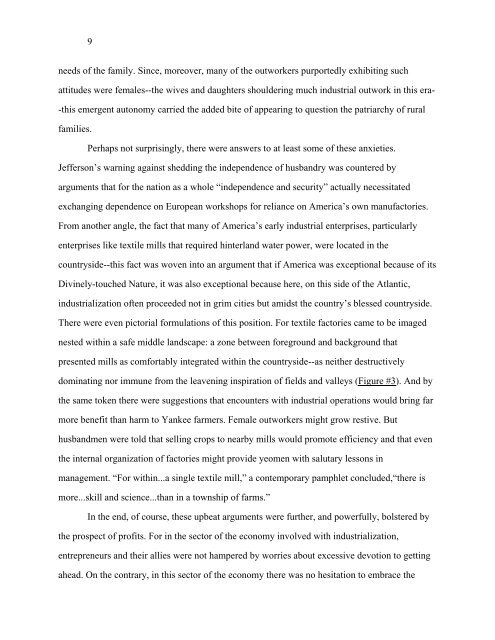1 Dr. Jonathan Prude, Emory University “The Great Transformation ...
1 Dr. Jonathan Prude, Emory University “The Great Transformation ...
1 Dr. Jonathan Prude, Emory University “The Great Transformation ...
You also want an ePaper? Increase the reach of your titles
YUMPU automatically turns print PDFs into web optimized ePapers that Google loves.
9needs of the family. Since, moreover, many of the outworkers purportedly exhibiting suchattitudes were females--the wives and daughters shouldering much industrial outwork in this era--this emergent autonomy carried the added bite of appearing to question the patriarchy of ruralfamilies.Perhaps not surprisingly, there were answers to at least some of these anxieties.Jefferson’s warning against shedding the independence of husbandry was countered byarguments that for the nation as a whole “independence and security” actually necessitatedexchanging dependence on European workshops for reliance on America’s own manufactories.From another angle, the fact that many of America’s early industrial enterprises, particularlyenterprises like textile mills that required hinterland water power, were located in thecountryside--this fact was woven into an argument that if America was exceptional because of itsDivinely-touched Nature, it was also exceptional because here, on this side of the Atlantic,industrialization often proceeded not in grim cities but amidst the country’s blessed countryside.There were even pictorial formulations of this position. For textile factories came to be imagednested within a safe middle landscape: a zone between foreground and background thatpresented mills as comfortably integrated within the countryside--as neither destructivelydominating nor immune from the leavening inspiration of fields and valleys (Figure #3). And bythe same token there were suggestions that encounters with industrial operations would bring farmore benefit than harm to Yankee farmers. Female outworkers might grow restive. Buthusbandmen were told that selling crops to nearby mills would promote efficiency and that eventhe internal organization of factories might provide yeomen with salutary lessons inmanagement. “For within...a single textile mill,” a contemporary pamphlet concluded,“there ismore...skill and science...than in a township of farms.”In the end, of course, these upbeat arguments were further, and powerfully, bolstered bythe prospect of profits. For in the sector of the economy involved with industrialization,entrepreneurs and their allies were not hampered by worries about excessive devotion to gettingahead. On the contrary, in this sector of the economy there was no hesitation to embrace the















